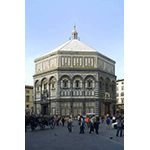Baptistery of San Giovanni
The Baptistery of San Giovanni is one of the oldest astronomical sites in the city of Florence. Already around the year One Thousand, there was an inlaid marble at its northern door, which represents one of the oldest astronomical documents of Florence. This is a "gnomon" which testifies to the interest for the apparent motion of the Sun: by means of a hole in the cupola, the solar rays struck the signs of the Zodiac carved on the marble, thus making it possible to check the Sun’s passage through the year. The author of this work might have been the medieval military captain and astrologer Strozzo Strozzi. In the course of the 13th century, after the flooring had been redone, the marble was moved to the eastern part of the Baptistery, and it is therefore not possible to evaluate its precision today. A similar-looking zodiacal marble is also found in the Church of San Miniato al Monte. In this case, however, there is no sufficient proof to establish whether the marble was only a decorative element or instead also performed a scientific function as a solar clock.
Galileo Galilei cites the Baptistery’s famous bronze doors in the sixth day of his Discorsi e dimostrazioni matematiche intorno a due nuove scienze [Discourses and Mathematical Demonstrations Relating to Two New Sciences] (Leyden, 1638): «He who closes the bronze doors of San Giovanni would attempt in vain to close them with a simple push alone; this mobile body requires continuous drive and a force so great that when it finally encounters and strikes the threshold, it makes the whole church tremble».
****************************
Texts by Graziano Magrini
English translation by Victor Beard
Last update 22/apr/2008




